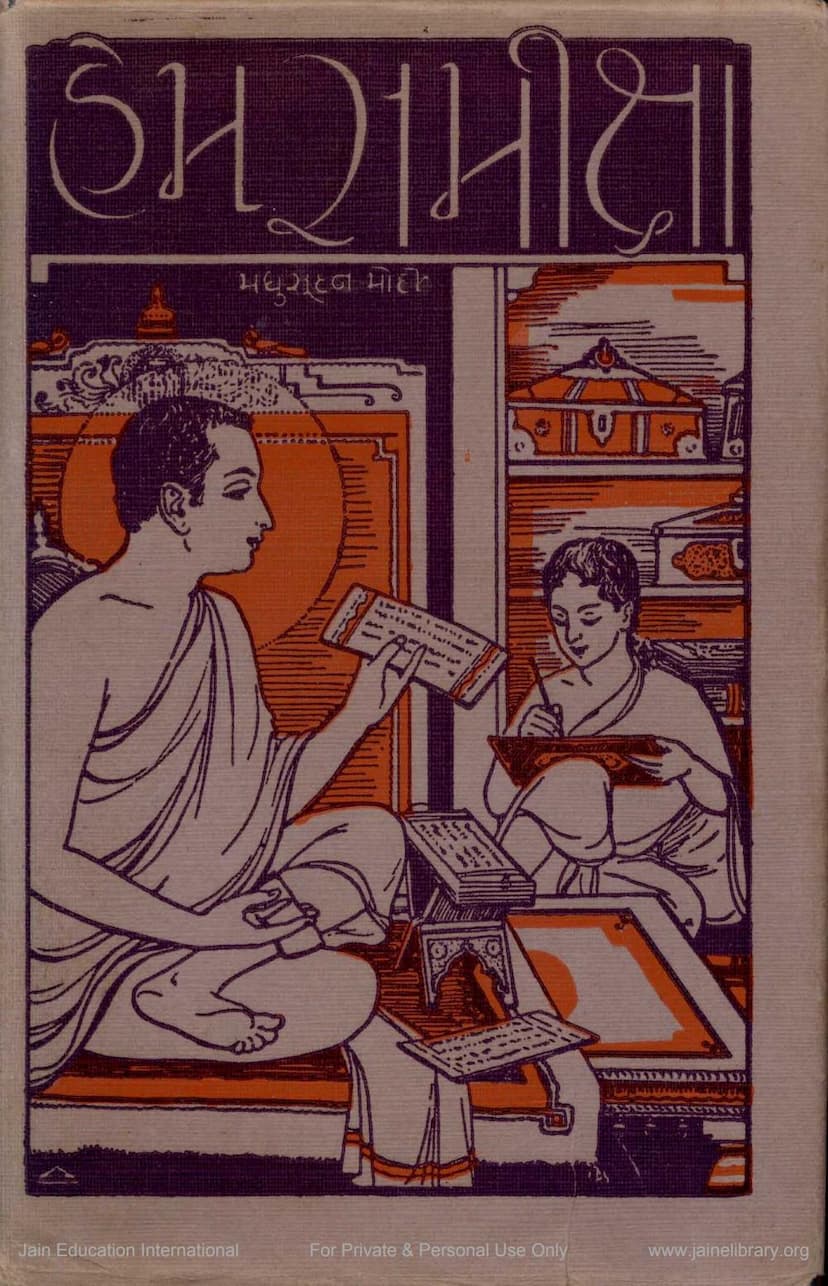Hemsamiksha
Added to library: September 1, 2025

Summary
Here's a comprehensive summary of the Jain text "Hemsamiksha" by Madhusudan Modi, based on the provided pages:
Book Title: Hemsamiksha (હેમસમીક્ષા) Author: Madhusudan Modi (મધુસૂદન મેદી) Publisher: Shri Atmanand Jain Shatabdi Smarak Trust (શ્રી આત્માનંદ જૈન શતાબ્દી સ્મારક ટ્રસ્ટ) Catalog Link: https://jainqq.org/explore/001986/1
Core Purpose and Content:
"Hemsamiksha" is a critical and comprehensive review of the entire available literary works of Acharya Hemchandracharya (હેમચંદ્રાચાર્ય), a pivotal figure in Jain tradition and Gujarati literature. The book aims to introduce and analyze the vast and diverse corpus of Hemchandracharya's writings, making them accessible to both Jain and non-Jain scholars and the general readership.
Key Themes and Contributions:
-
Introduction to Hemchandracharya's Works: The book serves as a guide to understanding the breadth and depth of Hemchandracharya's literary output. Modi highlights that despite Hemchandracharya's immense stature as a scholar and cultural beacon of Gujarat, a comprehensive understanding of his works was lacking for many. "Hemsamiksha" addresses this gap.
-
Comprehensive Analysis: Modi, an expert in Prakrit, Apabhramsha, and ancient Gujarati languages, meticulously examines each of Hemchandracharya's works. He delves into their content, style, structure, significance, and critical analysis. The book provides a valuable resource for understanding the intricacies of Hemchandracharya's scholarship across various fields.
-
Highlighting Hemchandracharya's Multifaceted Genius: The summary showcases Hemchandracharya's mastery in diverse subjects, including:
- Grammar: Particularly the "Siddhhemchandrashabdānushāsan" (સિદ્ધહેમચંદ્રશબ્દાનુશાસન), the primary focus, with detailed breakdowns of its eight chapters, including Sanskrit grammar, Prakrit grammar, Apabhramsha, and related works like "Unadigana Sutra" (ઉણાદિગણુસૂત્ર), "Lingānushāsan" (લિંગાનુશાસન), "Dhatuparayana" (ધાતુપારાયણ), and "Ganapatha" (ગણપાઠ).
- Lexicography: Works like "Abhidhanachintamani" (અભિધાનચિંતામણિ), "Anekaarthasangraha" (અનેકાર્થસંગ્રહ), and "Nighantuśeṣa" (નિઘંટુશેષ) are discussed, highlighting their importance for understanding Sanskrit vocabulary and etymology.
- Epic Poetry: The "Sanskrita Dvayāśraya Mahākāvya" (સંસ્કૃતદ્વયાશ્રય મહાકાવ્ય) is analyzed for its historical narrative of the Chaulukya dynasty and its role in illustrating grammatical rules, alongside the "Prākṛta Dvāśraya Mahākāvya" (પ્રાકૃતદ્વયાશ્રય મહાકાવ્ય) which focuses on Prakrit grammar and Kumarapala's life.
- Rhetoric and Prosody: "Kāvyānuśāsan" (કાવ્યાનુશાસન), discussed in detail with its commentaries, is presented as a systematic guide to poetics, significantly reducing the complexity found in earlier works like Mammata's "Kāvyaprakāśa."
- Metrics: "Chhandānushāsan" (છંદનુશાસન) is highlighted for its comprehensive analysis of Sanskrit, Prakrit, and Apabhramsha meters, offering valuable insights for understanding poetic rhythms and structure.
- Logic and Epistemology: "Pramāṇamīmāṁsā" (પ્રમાણમીમાંસા), though incomplete, is presented as a foundational work on Jain logic and epistemology, analyzing concepts of valid knowledge and refuting opposing philosophical views.
- Devotional Literature: The devotional works, including "Vītarāgastotra" (વીતરાગસ્તોત્ર) and "Anyayōgavyaavachchheda-Dvatrimśikā" (અન્યયેાગવ્યવચ્છેદ-દ્વાત્રિશિકા), are discussed, showcasing their blend of philosophical reasoning and devotional sentiment.
- Biographies: "Triṣaṣṭiśalākāpuruṣacaritra" (ત્રિષષ્ટિશલાકાપુરુષચરિત) is described as a monumental epic detailing the lives of sixty-three illustrious figures in Jain tradition, significant for its historical and cultural insights. "Pariśiṣṭaparvan" (પરિશિષ્ટપર્વ), a supplement to the biography, is also analyzed for its rich collection of narratives.
- Yoga: The "Yōgaśāstra" (યોગશાસ્ત્ર) is examined for its practical spiritual guidance, aiming to lead individuals towards liberation, with a focus on ethical conduct and mental discipline.
-
Addressing Criticisms and Historical Context: Modi addresses potential criticisms, such as accusations of plagiarism, by contextualizing Hemchandracharya's approach as a synthesis and simplification for educational purposes. He also places Hemchandracharya's work within the historical and cultural context of Gujarat, tracing the evolution of religious and literary traditions that influenced his era.
-
Scholarly Rigor and Personal Devotion: The book is a testament to Madhusudan Modi's deep scholarship and personal devotion to Hemchandracharya. The author's approach is marked by meticulous research, critical analysis, and a sincere effort to present Hemchandracharya's legacy in its entirety.
-
Structure and Presentation: The book is well-structured, beginning with introductory remarks, forewords by prominent scholars like Shri Jinavijayji, and the author's preface. It then systematically analyzes Hemchandracharya's works, providing detailed summaries and critical evaluations. The inclusion of indices and cross-references (as suggested by the catalog link) would further enhance its scholarly value.
Overall Significance:
"Hemsamiksha" is a monumental work that honors the legacy of Acharya Hemchandracharya. It makes his vast and complex literary output accessible, offering invaluable insights into Jain philosophy, Indian linguistics, history, and culture. Madhusudan Modi's dedication in compiling and analyzing this extensive material makes the book a crucial resource for anyone seeking to understand one of India's most influential intellectual and spiritual figures. The book emphasizes Hemchandracharya's role not just as a scholar but as a cultural architect who shaped the identity of Gujarat.